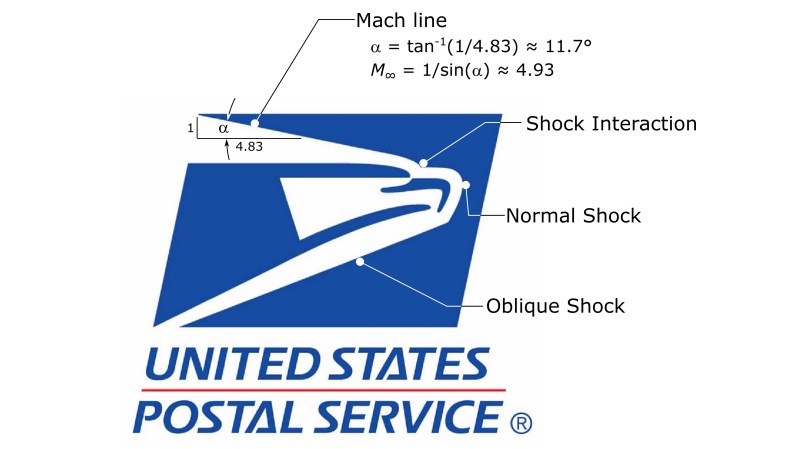The logo for the United States Postal Service is a mean-looking eagle. But a true fluid dynamics geek might look at it and realize that eagle is moving so fast it’s causing a shock wave. But just how fast is it moving? [Andrew Higgins] asked and answered this question, posting his analysis of the logo’s supersonic travel. He claims it’s Mach 4.9, but, how do we know? Science!
It turns out if something is going fast enough, you can tell just how fast with a simple picture! We’ve all seen pictures of jets breaking the sound barrier, this gives us information about the jet’s speed.

How does it work?
Think about it like this: sound moves at roughly 330 m/s on Earth at sea level. If an object moves through air at that velocity, the air disturbances are transmitted as sound waves. If it’s moving faster than sound, those waves get distributed downstream, behind the moving object. The distance of these waves behind the moving object is dependent on the object’s speed.
This creates a line of these interactions known as a “Mach line.” Find the angle difference of the Mach line and the direction of travel and you have the “Mach angle” (denoted by α or µ).
There is a simple formula for determining the speed of an object using the Mach angle, the speed of sound (a), and an object’s velocity (v): sin(µ) = a / v. The ratio of v to a is known as the Mach number, (M). If an object is going exactly the speed of sound, it’s going Mach 1 (because v = a).
Since Mach number (M) is v / a, we can plug it into the formula from above as 1 / M and use [Andrew]’s calculation shown in the image at the top of the article for a Mach angle (µ) of ~11.7°:
The real question is, did the USPS chose Mach 4.93 as a hint to some secret government postal project? Or, was it simply a 1993 logo designer’s attempt to “capture the ethos of a modern era which continues today”?
















To put it into terms of an actual speed, you would need to know the density of the medium in which it is moving.
What’s the density of red tape?
Just be glad we don’t get all the red tape that we pay for!
Infinite!
Excellent got a real life guffaw out of me.
For AusPost the logo should be a brick through your window.
In air / gas it depends only on temperature. There is no density involved. It is about the speed of the molecules and their elastic collisions, which is temperature.
I hate to break the news to you, Danny, but April First has already come and gone…
Density and… elasticity and things.
What if it’s just surface waves on water?
But then you’d have to state speed in knots, wouldn’t you?
Knots are pretty much like miles per hour, just more expensive.
Is that faster than an unladen swallow?
African or European swallow?
African or European?
You’re using coconuts!
I prefer W. A. S. T. E.
…Ugh. They took the angle using horizontal as reference, not the direction of travel. C-.
There’s a surprising amount of college level treatment of aerodynamics that asserts that anything acting vertically is lift, anything acting horizontally in one direction is drag, anything acting in the opposite direction to drag is thrust, and all that acts vertically downward is weight. Everything at 90 degrees to each other, always. I mean if you do it thoroughly it all comes out in the vectors but it inhibits intuitive feel for what is going on, and will lead you to booboos that you might otherwise catch, especially if applying it to other than aeroplanes.
I myself, NASA and any self respecting physicist prefer this at least..
https://www.grc.nasa.gov/WWW/K-12/airplane/climb.html
If we assume the top and bottom shocks are symmetrical and the eagle is moving at an upward angle then we can just use half the angle between the shocks for the calculation.
Measuring the two shocks I get an angle of 33 degrees, so that gives α = 16.5, and a resulting speed of about mach 3.52
doesn’t matter how fast it is when every other package goes to the wrong fuggin city
Where do you live???
Where the hell was this 2 1/2 weeks ago when it would have been perfect?
Uh … I believe this submission was sent via USPS … it’s actually early! /s
The logo is about the only thing that is fast about the USPS. Everything is a “day late and a dollar short” at my apartment. Birthday cards often show up a week later! Since I have gone almost completely online with my bills, I might as well have a trashcan with my apartment number on it instead of a mailbox because that’s all I get anymore…
I generally seem to get things the few things that I get through USPS pretty much on time, but for some reason, all the birthday cards that I send usually are about a week late. Hmmm… could I be doing something wrong?
Birthday Cards take longer to inspect and see if they could steel the money inside.
“MATHEMATICAL PROOF THE EAGLE IN THE USPS LOGO IS FAST!” is frankly a bit incorrect. (Both factually and grammatically. (should be “mathematics proves the eagle in”))
The formulas for calculating mach speeds are actually derived from empirical observations.
The fact that a gas stops behaving like a fluid when crossing the speed of sound makes it rather simple to express the angle of the resulting shock wave in proportion to the speed of the object relative to the speed of sound of the gas.
But if a gas were to have other ways of interaction that traveled faster than the speed of sound, then the shock wave would behave differently. Now, most gases do have other ways to interact that are in fact faster than the speed of sound (primarily thermal radiation, changes in gravity due to changes in density, etc) but since most of these other interactions are frankly rather negligible in comparison to the particles just getting pushed about as if they were marbles, then we can largely just consider the later case in our approximations.
Meaning that we have made the problem into a simple geometrical expression of the air getting pushed aside at the speed of sound, while our object moves forth at a speed greater than the speed of sound. This in turn gives us a simple triangle. Though it is only an approximation. One that in this case happens to be very close reality relatively speaking.
But the accuracy of this approximation would diminish if gases had more significant modes of interactions above the speed of sound.
Converting the mach speed to kt, mph, km/h, or m/s would require more empirically derived constants to calculate these values. It can’t be done with mathematics alone to be fair.
Though, some people say that mathematics can prove/explain anything. Or that for example logic is simply a subfield of mathematics. (something that is fairly trivial to disprove.)
A mathematical proof on the other hand doesn’t just toss away part of a problem just because it is negligible.
(in physics and engineering on the other hand, tossing out negligible effects is fairly common and fully accepted.)
Though it’s in the Constitution, there are rumblings of a roost and wing clipping of the speeding eagle. The solvency of the pension is the stone around it’s neck. Paper ads (in the screen age) are it’s mainstay, mine filled a trashcan under the mailbox that was full after a year from USPS. That’s a lot of nest building material.
The government mandated the USPS has to squirrel away a massive amount of money for their retired workers’ pension fund. Far more money than could possibly be disbursed even if every former postal employee lived to 100.
Last I looked it up, the fund has grown to over $10 billion. The USPS needs a whole new fleet of delivery trucks and could definitely use some more employees, especially when they rarely, if ever, have all the registers staffed at the busiest times.
The fleet of Grumman LLV’s are 26 to 33 years old and the ones that haven’t gone completely to pieces have been rebuilt at least once.
I was once stopped behind a postal truck…and the logo looked like a duck with its head turned back to the left over its white wings……and I could never see the eagle in the logo again
It takes a bit of squinting, but I think I can see your duck.
I would recommend reading the excellent comic strip from Jean-Pierre Petit : “The silence barrier”.
http://www.savoir-sans-frontieres.com/JPP/telechargeables/English/THE_SILENCE_BARRIER.pdf
Also available in numerous languages on the website.
But is it really the eagle that is fast? Is it traveling solely under it’s own power? Or did they launch it somehow?
What this really represents is a late 80s through early 90s project where the USPS was experimenting with delivering food right to people’s door. You see firing a bird through a specialized cannon was a way to pluck, cook and deliver the bird all in one step. Had they succeeded such efficiency would have revolutionized the food industry.
Alas, they never quite figured out how to land the food in a way that was safe, clean and appetizing and the project ran out of funding. However, no one really knows what goes on at their Isla Nublar research facitlity. Given recent events it seems likely they would revisit this project.
Luv it. One can only hope! 🐔
What a terribly inefficient way to calculate the Mach number!
Gross approximation or not, if we assume the sine and arctangent (or, ahem, “inverse of tangent”, as some people like to call it) are a reasonable pair of formulas for obtaining a workable Mach number… there is a better way to obtain the same result!
Enter Pythagoras!
You see, arctangent takes “rise over run” and gives us the angle. We have a “run” of 4.83, for a “rise” of 1. Fair enough; we get angle “alpha”.
But then this Mach formula, as illustrated, turns that angle “alpha” right back into a ratio of right-angle triangle sides!
Sine takes an angle and gives us “opposite over hypotenuse”. Well, the side “opposite” of “alpha” has a value of 1, so we get 1/h, where h is the hypotenuse.
But look! Mach number is 1/sine(alpha), or 1/(1/h)… which is… h! The hypotenuse! The Mach number is the hypotenuse!
So a simple application of the Pythagorean theorem can give us the Mach number, DIRECTLY, as long as the “rise” of the slope is normalized to 1! …Which in this diagram, it already is.
The calculation? M = sqrt(1 + 4.83^2)
…
Why is this better? Because it involves only three operations: a square, a square root, and dirt-simple addition of +1.
Computers and microprocessors can square a number very quickly and efficiently, and there are efficient binary algorithms especially tuned for calculating square roots. Oh and incrementing a number by 1 is so blazingly fast on a microprocessor, it barely even needs a mention.
Compare with trigonometric calculations, which can only be done either by enormously space-inefficient floating-point look-up tables, or by iterating through enormously time-inefficient Taylor/Maclaurin polynomials until the desired level of precision is achieved.
…
If you’re going to program a microprocessor to do such calculations (which seems fitting, given the typical audiences of HACKADAY)… then for the love of god and all that is holy, please, Please, PLEASE give some thought to the mathematics involved, and optimize your algorithms as best as possible for your application.
This goes slightly over my dumb head, but I’m pretty sure they chose Mach 4.93.